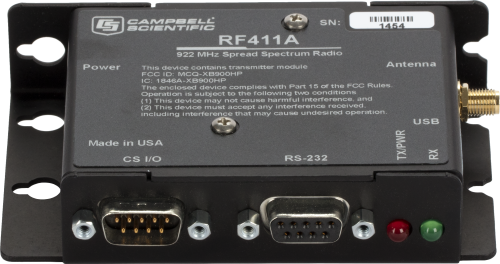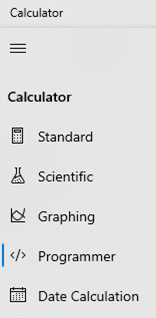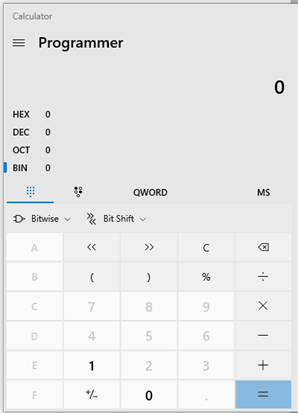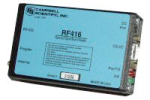
概要
RF411A は、オーストラリアやニュージーランドを含むいくつかの国でライセンスフリーで使用できるように設計された 900MHz 無線です。コンピュータ、データロガー、測定デバイス間の長距離ワイヤレスリンクを簡単に作成できます。RF411A の動作周波数範囲は 920~928MHz で、送信電力出力は 5~250mW に設定できます。
RF411A は、RF410、RF411、RF431 など、RF400 シリーズの無線の前身製品すべてと互換性があります。つまり、CR210、CR211(X)、AVW211 とも互換性があります。
注意: RF411A 無線は、RF411、CR211、AVW211 などの製品との互換性が必要な既存のインストールに推奨されます。新規インストールの場合、Campbell Scientific は RF412 または RF451 の使用を推奨します。
続きを読む利点と特徴
- 堅牢で低コストのトランシーバ
- 現場でトランシーバとして、またはオフィスでベース ステーションとして使用できます
- 全方向性アンテナで最大 1マイル送信、理想的な条件で高ゲイン指向性アンテナで最大 10マイル送信
- 設定は不揮発性メモリに保存されます
- コンピュータに接続するための RS-232 ポート。データロガーに接続するための CS I/O ポート
- 25チャンネルを超える周波数ホップにより、他のスペクトラム拡散無線からの干渉を回避
- オプションの拡張温度テスト
- 一部の小さな「リンク ステート パケット」の排除による通信の高速化
- スタンドアロン RF ルーター/リピータ (最大 8つのリピータ) の使用が可能
- RF 再試行を使用することで、干渉や RF 衝突に対する耐性が向上
- 無線が「パケット アドレス フィルタリング」を実行するため、データロガーの消費電力が削減
- 組み込みのセットアップ メニューにより、高度な機能にアクセスできます
- PakBus ネットワークでの使用向けに設計
イメージ








詳細
RF411A は、900MHz のライセンス不要の ISM バンド操作用に設計された周波数ホッピング スペクトラム拡散無線です。動作周波数範囲は 920 ~ 928 MHz で、送信電力出力は 5~250mW に設定できます。CS I/O、RS-232、USB を含む 3つの選択可能なアクティブ接続のいずれかを提供します。逆極性SMA(RPSMA)アンテナ ジャック接続を備えています。RF410、RF411、RF431、CR210、CR211(X)、AVW211 などの従来の 9XStream 製品と無線互換性があります。
仕様
| 無線タイプ | 周波数ホッピングスペクトラム拡散(FHSS) |
| 周波数 | 920~928MHz |
| 使用されている国 | オーストラリア、ニュージーランド |
| 伝送距離 |
|
| 出力 | 5 ~ 250 mW (ソフトウェアで選択可能) |
| 受信感度 | -109 dBm (Campbell Scientific プロトコルは、ビット エラーが発生するたびに再試行を実行します。) |
| RFスループットデータレート | 9.6 kbps |
| データレート | 10 kbps |
| アンテナコネクタ | 逆極性SMA(RPSMA)ジャック |
| LED について | 電源オン、Tx、Rx、診断 |
| RS-232 ボーレート | 1200 ~ 115200 bps |
| CS I/O モード | SDC 7、8、10、11、および ME マスター |
| 平均電流消費量 |
|
| 電源 | 9 ~ 16 Vdc |
| 電源コネクタ | 2.5 mm DC電源ジャック |
| 動作温度範囲 |
|
| 通信ポート |
|
| サービス要件 | 他のデバイスと周波数を共有します。 ライセンスされた無線に有害な干渉を引き起こしてはなりません。見通し線が必要です。 |
| 寸法 |
11.1 x 6.9 x 2.7 cm (4.4 x 2.7 x 1.1 in) 寸法は、アンテナ コネクタの先端からケースの反対側まで、およびケースの底部から DB9 コネクタ ジャック ネジの上部までです。幅には、ケースを固定するネジのネジ頭の厚さも含まれます。 |
| 重量 |
|
認定資格 |
|
| 米国 (FCC Part 15.247) | MCQ-XB900HP |
| カナダ産業省 (IC) | 1846A-XB900HP |
| C-TICK オーストラリア | Yes, N3013 |
互換性
通信
RF411A は、RF411、RF431、CR211、CR211X、AVW211 と無線で互換性があります。
その他のスペクトラム拡散無線
RF411A は RF410 および CR210 とも互換性がありますが、通信プロトコルは transparent に設定する必要があります。また、RF410 および RF411A 無線が同じ RF 近接性にある場合は、RF410 ネット アドレスに 28、44、52、56、または 60 を使用しないでください。ネット アドレスが 28、44、52、56 の RF410 無線は、ネット アドレスがそれぞれ 0、1、2、3 の RF411A 無線と干渉します。RF410 ネット アドレスが 60 の場合、すべての RF411A ネット アドレスと干渉します。
Campbell Scientific では、FGR-115 または RF450 無線を含むネットワークで RF411A を使用することは推奨していません。
Transparent プロトコルと PakBus プロトコル
Transparent プロトコル設定を使用する RF411A 無線と、PakBus プロトコル設定を使用する RF411A、RF411、RF431、CR211(X)、または AVW211 デバイスを混在させないでください。混在させると、RF トラフィックが失敗します。ただし、PakBus Aware 設定と PakBus Node 設定の無線は、同じネットワークに共存できます。
データロガーの考慮事項
| データロガー | RS-232 | CS I/O |
| CR200(X) |  |
|
| CR800/CR850 |  |
 |
| CR1000 |  |
 |
| CR3000 |  |
 |
| CR5000 |  |
 |
| CR9000(X) |  |
|
| CR300 |  * * |
|
| CR6 |  |
 |
| CR510-PB |  |
|
| CR10X-PB |  |
|
| CR23X-PB |  |
|
| Mixed-array データロガー | ** |
注意:
*18663 ヌル モデム ケーブルを使用してください。
**データロガーの CS I/O ポートと RF411A の RS-232 ポートの間に SC932A または SC105 を使用して、mixed-array データロガー (CR10、CR10X、CR23X、21X、CR7 など) を接続することができます。
ダウンロード
RF401A Series OS v.05 (438 KB) 22-07-2015
Current RF401A and RF411A firmware. Requires the Device Configuration Utility.
Device Configuration Utility v.2.32.01 (47.7 MB) 15-04-2025
A software utility used to download operating systems and set up Campbell Scientific hardware. Also will update PakBus Graph and the Network Planner if they have been installed previously by another Campbell Scientific software package.
Supported Operating Systems:
Windows 11 or 10 (Both 32 and 64 bit)
よくある質問
RF411Aに関するよくある質問の数: 6
すべて展開すべて折りたたむ
-
RF401A と RF411A は、最大送信電力の向上、平均消費電力の低減、パッケージの改善、USB、RS-232、CS I/O を 1 つのデバイスに統合するなど、前モデルに比べて明確な利点を備えています。
- RF401A は、RF400、RF401、RF430 など、RF400 シリーズの無線機の前身機種すべてと互換性があります。また、RF401A は、CR205、CR206X、AVW206 とも互換性があります。
- RF411A は、RF410、RF411、RF431 を含む RF400 シリーズ無線機の前身機種すべてと互換性があります。また、RF411A は CR210、CR211X、AVW211 とも互換性があります。
-
これらの無線機には、SC12 シリアル ケーブルと 10873 RS-232 ケーブルが付属しています。
-
この製品の USB デバイス ドライバは、Device Configuration Utilityに同梱されています。Device Configuration Utilityの最新バージョンを使用していることを確認してください。
- Device Configuration Utilityを開いたら、デバイスのリストからこの製品を選択します。
- 画面の指示に従って USB デバイス ドライバをインストールします。
- 指示内のインストール リンクをクリックして、インストール プロセスを開始します。
-
アンテナの選択は複数の基準によって決まります。
- 特定のステーションが通信する必要があるステーションの数を考慮してください。 1 つのリピーターまたはベース ステーションとのみ通信するリモート ステーションの場合、指向性アンテナまたは八木アンテナが適切な選択肢となる可能性があります。 対照的に、さまざまな場所からデータを受信するリピーター ステーションでは、全方向性アンテナが必要になる可能性があります。
- 2 点間の経路を越えるには高利得アンテナが必要かどうかを検討してください。高利得アンテナはより大きく、より高価になります。
アンテナの選択と設置場所の配置を支援するために、デモ キットをレンタルして使用し、経路の品質をテストすることを検討してください。Campbell Scientific は、RF401、RF430、CR206X、AVW206 用の 900 MHz デモ キットと、RF450 用のデモ キットを提供しています。サポートについては、Campbell Scientific にお問い合わせください。
-
何ヶ月も安定して動作していた RF401/RF401A/RF407/RF411A/RF412/RF427 ネットワークが突然断続的なデータ収集で機能しなくなり、現場に変更はなく、その地域で新しい建設工事も行われていない場合、問題は COVID-19 パンデミック中に現場に設置された新しい機器によって発生している可能性があります。
COVID-19 パンデミックのため、一部の現場では接触追跡と社会的距離の確保のためにバッジ センサ技術を導入しました。多くの場合、これらのデバイスは Wi-Fi または Bluetooth で動作しますが、一部は当社のスペクトラム拡散無線で使用される 900 MHz 範囲で動作し、干渉を引き起こす可能性があります。幸い、無線チャネル マスキングを使用してこの問題を解決できます。
以下に、1 つの具体的な例でこの問題を修正するために実行された手順の概要を示します。
- COVID-19 バッジ機器のデータシートが見つかり、確認したところ、915~926 MHz で動作していることが判明しました。
- RF407 900 MHz スペクトラム拡散無線のマニュアルを確認しました。マニュアルには、ビット 0 とビット 63 の周波数がそれぞれ 902.4 MHz と 927.6 MHz、チャネル間隔が 400 KHz であると記載されていました。
- 数学的計算により、チャネル 31 から 60 をマスキングすると、914.8 MHz から 926.4 MHz までがブロックされることが判明しました。
- 2 進数から 16 進数へのコンバーターに 00000000000000000000000000000001111111111111111111111111111111110000 と入力すると、FFFFFFFC0000000F のマスクが生成されます。(Windows が提供する既定の電卓アプリには、ハンバーガー メニューの下に、変換に使用できるプログラマー オプションがあります。)


- 無線チャネル マスク設定で FFFFFFFC0000000F のマスクが使用され、無線ネットワークは信頼性の高い動作を再開しました。
無線チャネル マスキングの使用に関する詳細については、スペクトラム拡散無線のマニュアルを参照してください。たとえば、RF407 シリーズのマニュアルには、このトピック専用のセクションがあります。
Privacy Policy Update
We've updated our privacy policy. 詳細はこちら
Cookie Consent
Update your cookie preferences. クッキーの設定を更新する

